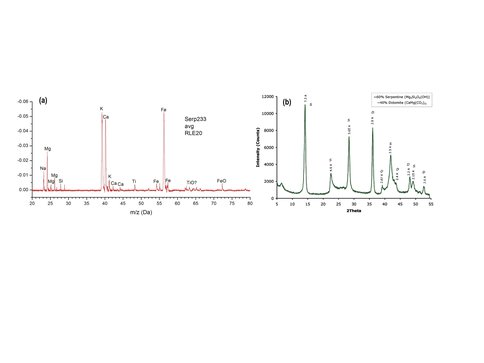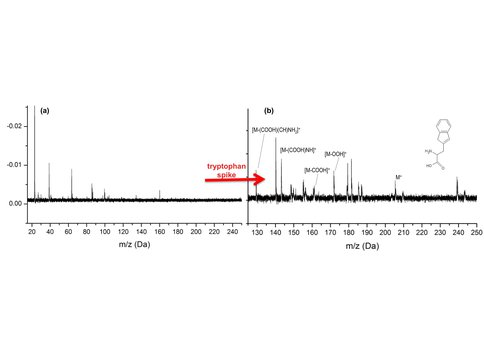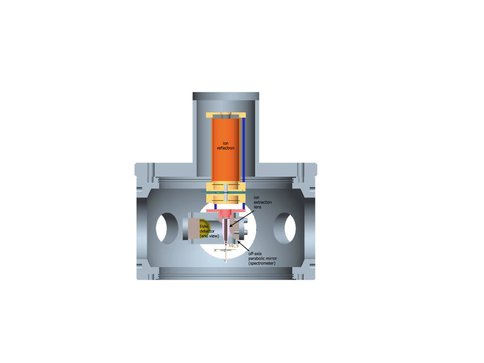2010 Annual Science Report
 NASA Goddard Space Flight Center
Reporting | SEP 2009 – AUG 2010
NASA Goddard Space Flight Center
Reporting | SEP 2009 – AUG 2010
Advancing Techniques for in Situ Analysis of Complex Organics
Project Summary
Our research in laser mass spectrometry is part of the overall program of the Goddard Center for Astrobiology to investigate the origin and evolution of organics in planetary systems. Laser mass spectrometry is a technique that is used to determine the chemical composition of sample materials such as rocks, dust, ice, meteorites in the lab. It also may be miniaturized so it could fit on a robotic spacecraft to an asteroid, a comet, or even Mars. On such a mission it could be used to discover any organic compounds preserved there, which in turn would give us insight into how Earth got its starting inventory of organic compounds that were necessary for life. The technique uses a high-intensity laser to “zap” atoms and molecules directly off the surface of the sample. The mass spectrometer instantly captures these particles and provides data that allow us to determine their molecular weights, and therefore their chemical composition. Our recent work has been to understand the different kinds of spectra one obtains when analyzing complex samples that are analogs of Mars and other planetary bodies, such as phyllosilicate-bearing rocks that have been identified on Mars and may indicate past conditions where life could have developed in the presence of water. We also have been improving the instrument to better detect certain kinds of organic compounds in such complex rocks, such as to selectively ionize certain hydrocarbons and simplify data analysis, and to create chemical maps of the sample surface.
Project Progress
Note: This report covers the period July 2009 – June 2010, Goddard Center for Astrobiology (GCA) Theme 4 work using laser time-of-flight mass spectrometry (TOF-MS) techniques included activities under CAN-5 (started FY09).
1. Objectives
The overall objective of the line of work associated with technique and protocol development using laser mass spectrometry (MS) is to develop protocols for analysis of complex, nonvolatile organic molecules, such as those that might be found at Mars, Titan, comets, and other planetary bodies, with limited chemical sample manipulation, preparation, processing (as may be required by flight missions). The GCA laser MS effort is deliberately complementary to both (i) instrument development work supported by NASA programs such as ASTID, to forward the design and testing of new prototype spaceflight hardware, and (ii) ongoing research and development within Theme 4 of the GCA, concerning analytical chemical sample analysis as well as across GCA (particularly with Theme 3) to define combined analysis techniques that may affect future mission design. There are additionally aspects of this effort that relate to understanding synthetic pathways for certain complex organics in planetary environments. Areas of activity during this period included:
- Development of libraries and protocols for laser MS of phyllosilicate-rich analogs
- Two-step laser MS (L2MS) development
- Sample probe system for microanalysis and reflectance spectroscopy
2. Summary of Progress
2.1 Development of libraries and protocols for laser MS of phyllosilicate-rich analogs
Both available TOF-MS prototypes in the laser mass spectrometry laboratory at Goddard were used to examine the characteristics of acquired data from desorption/ionization of phyllosilicate-rich analog samples. This study was conducted with combined support from NAI and the Mars Instrument Development Project (MIDP), which seeks to develop and analyze a precision (mm-scale) solid sampling tool, with heterogeneous clay-mineral analogs used as a key example. Extensive phyllosilicates exposed in key regions on Mars such as Nili Fossae and Mawrth Vallis may suggest a stable, water-rich past epoch on Mars with high habitability potential including possible preservation of organic molecules in clay-rich phases. Rock samples at such locales are likely to be highly complex suggesting that precise, fine-scale (e.g., laser) analysis and/or subampling may be required to minimize analytical risk associated with bulk analysis. The analyses included serpentine-rich and kaolinite-rich analogs.
Serpentine: Serpentine may result from aqueous alteration of ultramafic rocks under neutral to alkaline conditions and has been detected in altered olivine-bearing bedrock at Nili Fossae (Ehlmann et al., 2009). Alkaline alternation is also supported by the detection of carbonates. These neutral to alkaline environments may have been less challenging for life than more acidic conditions. Serpentization may additionally produce methane. The serpentine deposits at Nili Fossae are ancient, but if serpentinization occurred in more recent times, it could be a source of some of the methane recently observed in Mars’ atmosphere (Mumma et al., 2009). Serpentine-rich analog powders were acquired with subsampling development tools applied to two field hand specimens. Sub-mg quantities were mounted on the laser TOF probe stub and analyzed under high vacuum (0.2 mtorr) with a sequence of ~ten of laser pulses at 266 nm. Example atomic mass range spectra for samples “Serp233” and “Serp3” are shown in Figs. 1a, 2a showing a number of major and minor detected elements consistent with the mineralogy. In both cases sample splits were additionally analyzed by a Terra powder x-ray diffraction instrument that is similar to the CheMin instrument on MSL. The strong Ca signal in the TOF-MS spectra of Serp233 is consistent with the identified major component of dolomite in this specimen (Fig. 1b). Minor metal cation substitutents typically found in clay minerals are also readily detected, the high laser TOF sensitivity to Cr (of particular interest for assessing clay formation and evolution) in the purer serpentine (Fig. 2b) consistent with available Terra data.
These data contribute to library and protocol development in particular where mass spectra alone cannot disambiguate the detection of organics, where mineral-associated ions may be found at overlapping m/z values with organic fragments. As has been documented in earlier NAI work, knowledge of elemental and mineralogical composition is critical to the final interpretation of putative organic fragments and their association with parent ion signals. For example typically appearing CrO (Fig. 2a) other transition metal oxide cations can interfere with primary fragments of carboxylic acids and polycyclic aromatic hydrocarbons, in the range m/z 60-110; however presence of neutral loss patterns (16 Da for O vs. 12 Da for C) can be used to identify peaks if consistent with other spectral data.
Figure 1. Fig. 1 (a) UV +ion LD-TOF and (b) XRD (Terra) data for a serpentine-dolomite analog . Subsamples acquired: < 1 mg for LD-TOF; ~15 mg for XRD. Miniature LD-TOF averages of < 10 laser pulses. Terra uses Co excitation source and Jade data analysis.
Figure 2. Fig. 2 (a) UV +ion LD-TOF and (b) XRD (Terra) data for a serpentine-rich analog with Cr metal substitution. Subsamples acquired: < 1 mg for LD-TOF; ~15 mg for XRD. Miniature LD-TOF averages of < 10 laser pulses. Terra uses Co excitation source and Jade data analysis.
Kaolinite & Tryptophan: Kaolinite may readily form on Mars in well-drained (high water-to-rock) and/or acidic environments from a basalt. Aluminum phyllosilicates are found in several areas on Mars, including Mawrth Vallis and Nili Fossae (Bishop et al., 2008; Ehlmann et al., 2009). Kaolinite spiked with tryptophan is one of the simplest “realistic” test samples for laser TOF of potential organic-bearing analogs. The major Kaolin cations such as Al and Si, with minor Ca, as well as the ubiquitous salt ions (Na, K) present in most terrestrial analog soils, are readily identified within a few tens of laser pulses (Fig. 3a). Admixture of an amino acid that has been given a chance to adsorb at the grain or layer scale of the clay, via centrifuge, results in fairly uniform detection of diagnostic organic peaks as shown in Fig. 3b. Tryptophan is a proxy for a range of smaller (lower molecular weight) aromatic organics that may be of interest.
Figure 3. Fig. 3 LD-TOF spectra of source clay (Clay Minerals Society) kaolin KGa-1B as neat powder (a) and spiked with centrifuge-adsorbed tryptophan (b). Reproducible fragmentation pattern for tryptophan parent ion observed in individual pulses.
Follow-up work using clay matrix samples will include a wider variety of materials such as monmorillonite and nontronite, as well as comparison of semi-volatile and nonvolatile organics over a range of molecular weights and concentrations, to standardize the analysis of selected field samples with more complex mineralogies.
2.2 Two-step laser MS (L2MS) development
Two-step laser techniques have proven extremely powerful in laboratory analysis of organics in rocks, meteorites, and returned samples for a number of years (e.g., Kovalenko et al. 1992; Mahajan et al. 2001; Elsila et al. 2004; Davis et al. 2009). The method enhances the sensitivity and selectivity for key classes of organics, such as trace aromatic hydrocarbons, allowing these to be distinguished from the many potentially-interfering fragments and clusters from the mineral matrix of a sample that appear in single-laser spectra. Such hydrocarbons comprise a fraction of the organic matter in carbonaceous asteroids and in comets, and may survive in the near surface of Mars, as suggested by the research of R. Zare and co-workers on martian meteorite ALH 84001 (e.g., Clemett et al. 1998). These compounds are further challenging to analyze with traditional methods such as pyrolysis MS. While a complete L2MS has not yet been developed for spaceflight applications, it could offer a leap in the sensitivity and selectivity of in situ analysis of complex organics on missions to bodies such as Mars, Titan, asteroids, and comets.
The L2MS method (Fig. 4) uses two laser pulses to introduce organic molecular ions into a TOF-MS. A first pulse desorbs molecular neutrals from the sample surface under vacuum conditions. Following an adjustable delay of several microseconds, a second laser pulse ionizes molecules in the volume just above the surface, allowing them to be accelerated into the TOF-MS for analysis. This approach offers analytical advantages over the simpler technique of laser desorption/ionization (LDI), where a single laser is used for both steps. First, the laser intensity required for neutral desorption is lower (by ~1 order of magnitude) than needed to generate prompt ions, resulting in less molecular fragmentation and surface modification. Second, the wavelength of each laser pulse in L2MS can be optimized separately for its distinct function, resulting in one or more orders of magnitude higher reproducibility and sensitivity when analyzing complex, unknown sample.
Figure 4 Bottom. Fig. 4 L2MS (a) combines coaxial near IR desorption (laser 1) of neutral molecules and lateral UV ionization (laser 2) to enhance sensitivities by more than an order of magnitude. With TOF-MS of simple analytes such as azo dye (b) we demonstrated that L2MS works in a miniature instrument© operating in the lab.
Initial results demonstrating the functionality of L2MS have been obtained with NAI support for developing sample analysis protocols. L2MS data were obtained from analysis of a blue organic dye standard containing methyl violet (penta- and hexa-methylated forms) and other compounds applied in a thin layer to an insulating substrate on the sample probe (Fig. 5). This standard has a reproducible LDI signature with a sharp laser intensity threshold for ion formation. The aromatic organics are additionally quite amenable to near-UV post-ionization. The test demonstrated that L2MS spectra are obtained with sub-threshold energy from the desorption laser (L1) and above-threshold energies from the ionization laser (L2). The pattern of peaks in the m/z range 200-400 Da is diagnostic of the methyl violet molecular ion with related neutral losses of multi-C ligand and CH3 (15 Da) groups.
Figure 5. Fig. 5 DS-TOF spectra of a methyl violet dye standard demonstrated that L2MS works on a highly miniature instrument. Top two traces show absence of signal with low (sub-threshold) laser 1 (L1) or laser 2 (L2) energies. L2MS spectrum in green occurs with increasing L2, while direct L1 ionization is only significant at higher L1 energies.
2.1 Sample probe system for microanalysis and reflectance spectroscopy
The laser TOF-MS approach is well suited to studies of fine-scale (< 1 mm) sample heterogeneity, in cases where a mission would permit access to intact solid samples for micro-analysis. Given the small scale of the laser spot (< 100 μm) larger individual mineral grains or inclusions (such as chondrules) could be probed revealing compositional complexity and variation across a surface. Likewise the importance of associating any organic compounds with minerals or rock matrix texture, particularly by comparison across mineral or other boundaries, suggests the need for local point-by-point analysis. With sufficient resources, the laser could be autonomously rastered across a few-mm or even cm wide sample to obtain a chemical image (4D data hypercube of x-y-m/z-intensity) analogous to microprobe analysis with a secondary ion mass spectrometer (SIMS). We are developing this capability for existing TOF-MS instruments with both laser rastering (driving a scanning mirror) and with xyz sample manipulation in vacuum. The former approach is simpler to implement but requires extensive calibration of desorption/ionization off the TOF axis. The latter approach is more complex, in most cases, but retains constant sample-TOF geometry. By comparing these methods using data from a set of well-characterized rock chip and meteorite thick sections we will be able to develop the best-working and lowest-risk approach to realizing this capability on a planetary surface mission.
Recent progress in this area supported in part by NAI has included the design and assembly of a new sample probe and instrument vacuum chamber for the Tower TOF-MS (Fig. 6) and an advanced design of a combined TOF-MS and IR reflectance spectrometer, based on an acousto-optic tunable filter (AOTF) light source (Chanover et al., 2003; Glenar et al., 2002). The AOTF instrument developed in collaboration with New Mexico State University (N. Chanover, PI) will permit contextual analysis of mineralogy and organic molecular bonding in conjunction with the high-sensitivity laser TOF analysis of the same sample region. The new chamber accommodates off axis laser incidence and low-f/# optical imaging via angled viewports, rather than the somewhat tricky long focal length design with on-axis laser incidence of the previous instrument. Under ASTID development we have redesigned the TOF Einzel lens inlet to be more tapered, so that the off-axis laser has enough clearance to scan about 2 mm on either side of the central point of the sample surface, with 10 micron precision. We additionally include a motorized XY stage for the sample to permit use of larger samples (up to 25 mm diameter) and to compare local probe capabilities. The incorporation of the AOTF required a novel light transmission and collection design involving a turning mirror with a center hole to accommodate the tapered ion lens (Chanover et al., 2010). All three hardware subsystems will be integrated in the next few months to be followed by extensive checkouts and protocol development activities for a variety of analog and meteorite samples.
Figure 6. Fig. 6 Design for combined laser TOF-MS and AOTF spectrometers in an experimental chamber permitting both laser raster-based and sample manipulation-based analysis of solid sample surfaces at fine scales, using both spectrometers on a common field of view. Tunable IR light is focused on and collected from the sample via a pair of parabolic mirrors in an F/1 imaging system, with a centerhole to accommodate the TOF ion extraction lens.
-
PROJECT INVESTIGATORS:
-
PROJECT MEMBERS:
William Brinckerhoff
Project Investigator
-
RELATED OBJECTIVES:
Objective 2.1
Mars exploration.
Objective 2.2
Outer Solar System exploration





